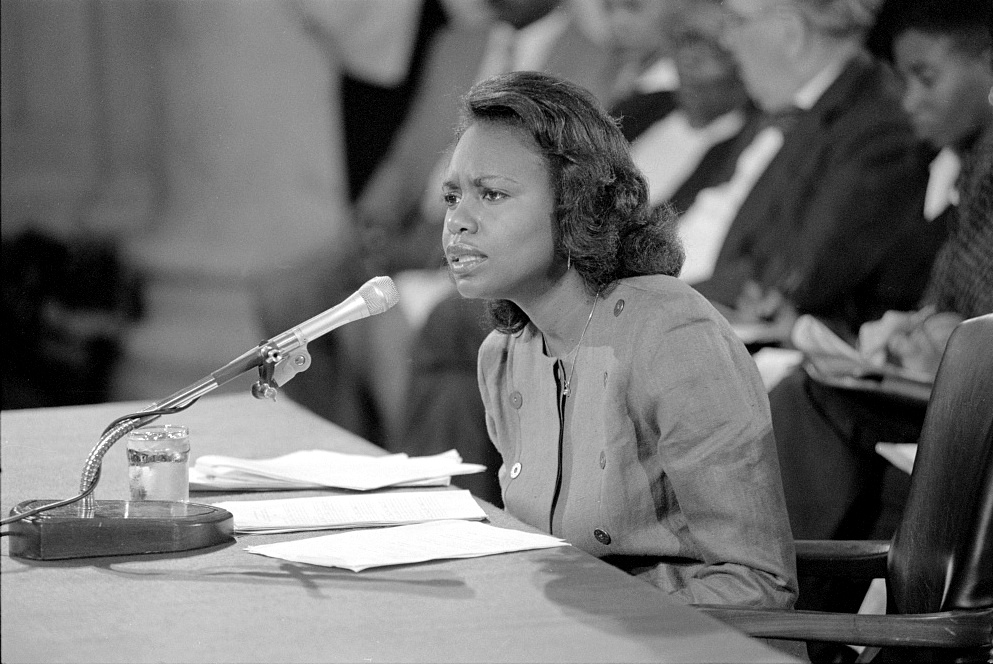14.2.3 The Third Wave: Identity and Difference
Valentin Quintus Nicolescu and Gregory Millard

A symbolic marker of the arrival of the third wave was the U.S. Senate Judiciary Committee hearings in 1991, in which Anita Hill claimed that Supreme Court Nominee Clarence Thomas had sexually harassed her when she worked as an advisor to him. Rebecca Walker’s 1992 article “Becoming the Third Wave(pdf)” channeled the ensuing outrage by criticizing the idea – fashionable at the time – that we were entering a “postfeminist” world. Walker called on young women to renew the struggle: “to be a feminist is to integrate an ideology of equality and female empowerment into the very fiber of my life. It is to search for personal clarity in the midst of systemic destruction, to join in sisterhood with women when often we are divided, to understand power structures with the intention of challenging them. While this may sound simple, it is exactly the kind of stand that many of my peers are unwilling to take. So I write this as a plea to all women, especially the women of my generation: let Thomas’ confirmation serve to remind you, as it did to me, that the fight is far from over. Let the dismissal of a woman’s experience move you to anger. Turn that rage into political power. Do not vote for them unless they work for us. Do not have sex with them, do not break bread with them, do not nurture them if they don’t prioritize our freedom to control our bodies and our lives. I am not a postfeminism feminist. I am the third wave” (Heywood, 2006, p. 5).
The Third Wave and Popular Culture
With the third wave, feminism expanded beyond its original civic and political areas of activism into mainstream pop culture, perhaps its most visible manifestation being the girl power movement. Feminist ideas and messaging contested patriarchal structures in show business and proved that popular culture and the mass media in general can be a fertile ground for activism and political messaging.

Girl power was arguably initiated by the emergence in the early 1990s of the Riot Grrrl movement in the U.S.A. and U.K. by the Washington D.C.-based band Batmobile. The term was intended to change the accepted perception of women and of their ability to create and perform on stage in a male-dominated pop-rock culture. During the late 1990s, the term was embraced by mainstream pop-bands like the Spice Girls. Nowadays, the movement is considered to be carried on by bands like Pussy Riot in Russia.
As the third wave developed, it came to focus on an integrative approach based on intersectionality and on feminist subjectivity. To some extent, it was the necessary development of several second wave issues such as an increasing awareness of the complexities of personal and gendered identity, the relationship between individual and group identity, and the limitations of the universalist assumptions of white middle-class feminism that dominated the previous waves. Core concepts of feminist thought – patriarchy and womanhood – were put under scrutiny. Barbara Arneil argues that the third wave was preoccupied by identity, difference (such as race, class, and sexual orientation), contradiction – not all identities tell mutually consistent or harmonious stories – and embodiment, i.e., an emphasis on the lived experience of women as embodied persons (Arneil, 1997, p. 255). The third wave stimulated an anti-universalistic view that empowers women to adopt more nuanced positions regarding their own identity and standpoints and emphasizes individual agency and the valorization of personal experiences. This rejected “grand narratives,” preferring to encourage social critique from “a wide array of discursive locations, and replac[ing] attempts at unity with a dynamic and welcoming politics of coalition” (Snyder, 2008, p. 176). From this perspective, there is no single and universal “woman’s experience.” Countering the first and second wave discourse, the feminists of the third wave employ a language of inclusivity based on differences. You can watch third wave feminist and theorist Naomi Wolf discussing third wave issues and perspectives below.
Video 14.1. Naomi Wolf: Third Wave Feminism by Big Think.
The emergence of the postmodern “standpoint theory” during the latter part of the 1980s offered third wave feminists a lens through which they could structure their approach, discourse, and direction of action. Social realities – indeed, all knowledge, including scientific knowledge (Harding, 1986) – are shaped by one’s social standpoint, these thinkers argued. The third wave raised fundamental questions regarding knowledge and forced a reevaluation of feminist roles, positions and discourses in a broader, more inclusive context that offered a renewed space and understanding of intersectionality.
Media Attributions
- Anita Hill testifying in front of the Senate Judiciary Committee © R. Michael Jenkins is licensed under a Public Domain license
- Pussy Riot by Igor Mukhin © Igor Moukhin is licensed under a CC BY-SA (Attribution ShareAlike) license

